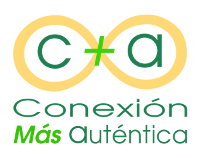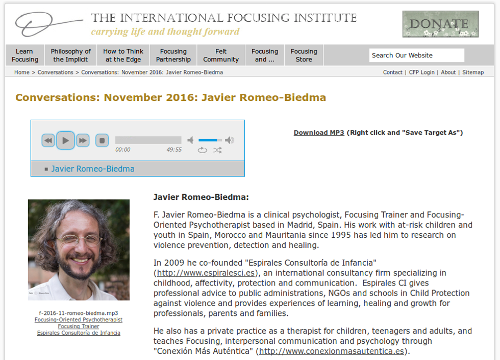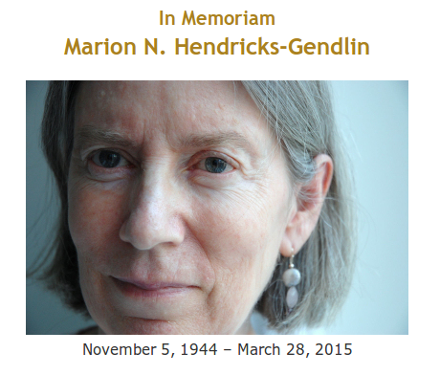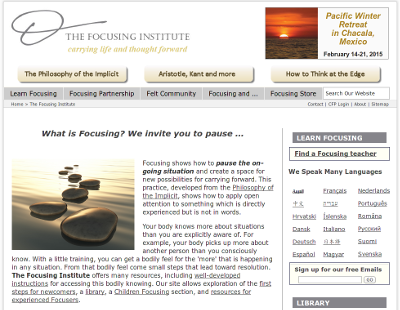daim ntawv lo lub hwj: Lus Askiv
My interview about “Focusing and how to work experientially with violence” for The International Focusing Institute
14 Kaum ib hlis 2016.
Cim npe: Tam sim no cov txheej txheem, Qwj CI, Focusing, Focusing thoob ntiaj teb, Lus Askiv, Kuv nthuav tawm, Hlwb, Kho, Sav Focusing, Yaam puab paub
A deep sense of honour and a distinct feeling of humility and shyness come to me when I share this interview. I can feel clearly the responsibility of talking about the work I do about “Focusing and how to work experientially with violence”, as the title of the conversation says. It is an important subject for me (I work a lot about it through Spirals tus me nyuam consulting, the international consulting firm specializing in Child Protection I co-founded), and trying to convey all its nuances is always a challenge.
Rau lub koom haum thoob ntiaj teb Focusing (the organization that coordinates internationally Focusing activities related to training and diffusion) fosters bimonthly “Conversations” with Focusing professionals all over the world. Serge Prengel, a Focusing Trainer and Focusing-Oriented Psychotherapist that I met at the International Focusing Conference 2016 in Cambridge (uk), acts as the host, and he does so in a very Focusing way –reflecting, with pauses, letting new ideas appear and develop in their own time.
In this “Conversation” you will find discussed issues like the following ones:
- Violence as a stopped process (“Something should have happened to carry forward a situation, and it did not occur, so the process gets stuck”).
- Harm defines violence, and harm is lived from the body.
- Finding a handle for violence (identifying it) is the first step out of it: becoming aware of our cultural patterns that normalize violence.
- The role of power in violence.
- Affection linked to care as a way to avoid violence –and the bodily dimension that can be reached through Focusing.
- Violence detection and intervention in Child Protection.
- A message of hope about healing and transforming violence, and Focusing as a wonderful tool to do it.
I hope that you will find an idea or two that might inspire your own experiential work about violence, and I will love to hear from you about it.
Nyeem daim ntawv no nkag teb chaws no ua lus Askiv (aunque la entrevista en sí está en inglés).
Lub zej zog Wellness Focusing paj pab pawg neeg ntawm lub Focusing sablaj hauv Cambridge (uk) 2016
7 Kaum ib hlis 2016.
Cim npe: Focusing Community, Focusing, Focusing nyob Spain, Focusing thoob ntiaj teb, Lus Askiv, Sav Focusing, Yaam puab paub
The Community Wellness Focusing Interest Group was for me one of the highlights of the International Focusing Conference in Cambridge (uk) July 20th-27th 2016. It was an experience of co-creating a community through listening, translation, our previous communities and Focusing attitude.
Some months have passed, and I have been writing about my experiences at the Conference (all posts indexed in this post in Spanish), and a warm and tender feeling comes to me when I remember this Group. Every morning during the Conference all participants joined one of the 15 Interest Groups. These were groups intended to be an open space to share personal and professional perspectives about Focusing in specific domains. I was tempted by many of the titles (there was even a “No-interest Interest Group”!) and I am very happy about my choice, while I regret not being able to split myself in order to attend to many others…
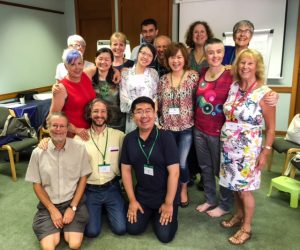
Community Wellness Focusing Interest Group at the International Focusing Conference, Cambridge (RU), Lub Xya hli ntuj 2016.
The Community Wellness Focusing Group was hosted by Nina Joy Lawrence, Pat Omidian and Heidrun Essler, who created a holding space for all of us to participate and, as they advanced, “to bring Focusing skills and attitudes into our daily lives and into community groups” –including our own group. Ua tsaug!
The first element was listening. We were sixteen participants from six different countries (Afghanistan, China, Germany, Spain, UK and USA), and not everybody was fluent in English, so the first step to build our community was to ensure that everyone could express themselves and understand anything that was said: that meant that we ended using three different working languages (Aaskiv, Chinese and Spanish). What could have been a burden (translating, for example, what a Chinese participant said to English, and then to Spanish, and then replying in English, and then translating to Chinese and to Spanish, and so on) became a precious gift: the possibility to listen to each other from a deep Focusing attitude, even before the words were translated. So we cultivated a slow-paced way of being together, a space where everyone was listening to people speaking in foreign languages and, somehow, at the end, we were starting to understand each other’s experience before translation.
A second experience that was very moving for me was translation itself. I have been translating in different settings and from different languages for over two decades, and very usually in professional settings (for example, translating foreign Focusing trainers here in Spain). But for me translating a Focusing conversation always brings a special effort, how to translate both the words and the implicit experience in those words.
That took me to a different level: the fact that I was translating (English and Spanish, both ways) in a group that felt like a community reminded me of how I used to translate immigrant teenagers for group-building in an association that no longer exists. When I shared that experience of both satisfaction about being able to translate in a community setting and grief about the disappeared association, other fellow members shared about the communities they had lost too –and how our previous communities were present and had a space in what we were creating.
During those four sessions we talked, tried exercises, commented, discussed… As I shared in the final row, I had arrived to the group with the main goal of getting ideas, techniques and exercises to create a community that uses Focusing. tiam sis, I have taken away something very different: mus rau Focusing attitude that fosters presence, that allows the group and each of its members to attend to a different quality of feeling, a connection that is kept in the body.
Those are some learnings that will stay for me (in fact I have visited Focusing Initiatives International, the organization that helps spread Community Wellness Focusing, and I have joined the Community Wellness Focusing Discussion List), as well as a deep gratitude toward our hosts and every member of the group. Now is the time to carry all these experiences forward creating communities with this Focusing attitude.
I wish for those of you who read me deep experiences of community-building like this.
Note: Picture posted with the permission of the members. No personal names are given in respect for their privacy, apart from the hosts that publicly offered the Interest Group.
Ideas from “Conversations at the Edge” with Gene Gendlin and Ann Weiser Cornell 2016
25 Lub kaum hli ntuj 2016.
Cim npe: Focusing Community, Focusing, Focusing thoob ntiaj teb, Lus Askiv, Sav Focusing, Yaam puab paub
Gratitude, awe and humbleness – those feelings stand up among all the rest after attending the latest course with Gene Gendlin and Ann Weiser Cornell about Focusing, the Philosophy of the Implicit and Gendlin’s work.
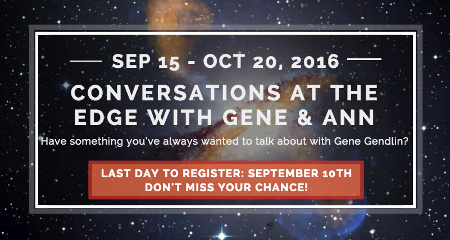 I am deeply grateful for having had the opportunity to join “Conversations at the Edge with Gene and Ann” during these past weeks of September and October 2016. Ann Weiser Cornell has been organizing these “Conversations at the Edge with Gene and Ann” several times a year through her platform Focusing Resources as a phone course by Gene Gendlin and herself in which participants can ask whatever they want: questions for Gene Gendlin, requests for ideas and even to be accompanied through a Focusing process by Gendlin himself.
I am deeply grateful for having had the opportunity to join “Conversations at the Edge with Gene and Ann” during these past weeks of September and October 2016. Ann Weiser Cornell has been organizing these “Conversations at the Edge with Gene and Ann” several times a year through her platform Focusing Resources as a phone course by Gene Gendlin and herself in which participants can ask whatever they want: questions for Gene Gendlin, requests for ideas and even to be accompanied through a Focusing process by Gendlin himself.
 Gratitude, awe, humbleness… I had already listened to audio and video files of Gene Gendlin, and I have found them very inspirational. But being with him in a conversation over the phone is something profoundly different. Even if I did not dare to ask anything during the first three sessions, listening to him interacting live with other people has a special quality. His presence, his openness, his clarity are very moving, and he shares his wisdom with some pearls of his knowledge and his attention.
Gratitude, awe, humbleness… I had already listened to audio and video files of Gene Gendlin, and I have found them very inspirational. But being with him in a conversation over the phone is something profoundly different. Even if I did not dare to ask anything during the first three sessions, listening to him interacting live with other people has a special quality. His presence, his openness, his clarity are very moving, and he shares his wisdom with some pearls of his knowledge and his attention.
And I want to share some of the ideas that I enjoyed the most:
- The concept of crossing, summarized by Gene: “Crossing makes it possible to say anything and be understood in some new way by saying it in a new system, saying ‘How is this (or can be) an instance of that?'” We can always say anything by expressing it from another point of view. A metaphor is possible by saying one thing in function of another: “A is, in a certain sense, B.”
- A fascinating discussion between Gene and a participant about how to define Focusing, and his objection about defining the necessary and sufficient for something to be Focusing. One of the many ideas is that “Focusing is staying with ‘that’, even when there is no relief yet.”
- Focusing as a way to listen to our inner movements: “There is a lot in us that wants to be heard and has not been heard yet. What is in me that wants to be heard?”
- A bright message of hope: “Focusing does not need trust [in the process] in advance,” meaning that we can start a Focusing process even distrusting something in us, and through the process we will arrive to trust it.
- Gene sharing that he considers himself “very biased in favour of keeping the good things and leaving the bad things apart,” meaning that he prefers to stay with the pleasant aspects of each process and not insisting and trying to “understand” (in the head) the painful aspects, once the process has solved them: “You do not need to go there,” he said.
- “Focusing is a technique, but not only a technique.”
- Focusing is always an inner process, even when we are Focusing on external objects (trees, landscapes, paintings…): there is always a body feeling.
- The formulation “Let’s stay a minute with that,” letting the word “that” contain all the meanings, without specific words, so when words come, they will be new and fresh.
- Talking about how a culture can configure a person’s experiences, Gene said: “Every human being is always more than their culture.”
- “The felt-sense is always more reliable than emotion or logic/reason alone.”
And I have a special memory of talking with Gene about my approach to find a handle for violence with Focusing, so we can all detect and prevent it, as I usually teach in my trainings for Child Protection professionals (social workers, psychologists, educators, teachers…) and families, and feeling his interest and receiving his support and encouragement.
There were many other interactions plenty of interesting ideas and experiences, with the presence of Gene and Ann. I keep them with care, and private.
So I feel gratitude, awe and humbleness for having spent these hours listening to Gene Gendlin live, with his warmth, his openness, his curiosity, his deep interest in what each participant had to ask or share. A true lesson. An inspiration. And a celebration.
I send from here my gratitude to Gene for being available and to Ann for making it possible at all levels.
With gratitude, awe and humbleness,
Taller sobre Focusing para la prevención de violencia en la Conferencia Internacional de Focusing 2016 Cambridge (United Kingdom)
23 Lub Xya hli ntuj 2016.
Cim npe: Txheej txheem archived, Qwj CI, Focusing, Kev kawm, Lus Askiv, Hlwb, Kho
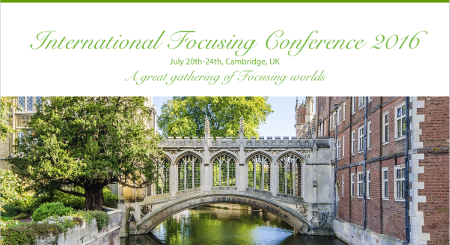 kev ua hauj lwm “Finding a Handle for Violence In Our Lives” (“Encontrar un asidero para la violencia en nuestras vidas”) sobre la aplicación del Focusing para la prevención de violencia en la 27ڤ International sablaj ntawm Focusing ntawm 2016 Cambridge (United Kingdom), organized los ntawm lub koom haum British Focusing Association, thiab qhib rau cov tswv cuab Tseev tsim ntiaj teb Focusing lub koom haum (Rau lub koom haum Focusing) thoob qab ntuj.
kev ua hauj lwm “Finding a Handle for Violence In Our Lives” (“Encontrar un asidero para la violencia en nuestras vidas”) sobre la aplicación del Focusing para la prevención de violencia en la 27ڤ International sablaj ntawm Focusing ntawm 2016 Cambridge (United Kingdom), organized los ntawm lub koom haum British Focusing Association, thiab qhib rau cov tswv cuab Tseev tsim ntiaj teb Focusing lub koom haum (Rau lub koom haum Focusing) thoob qab ntuj.
Hnub: Nueva fecha: Hnub Rau 23 Lub Xya hli ntuj ntawm 2016, ntawm 11:00 mus rau 13:00.
Chaw: Robinson College
Cambridge
United Kingdom
Descripción: Cuando trabajamos con infancia, adolescencia y juventud, con poblaciones en riesgo social, en entornos de intervención social, con clientes en terapia, podemos ver los efectos que tiene la violencia en sus vidas. En este taller vamos a trabajar de manera experiencial para encontrar un asidero para la violencia en nuestras propias vidas como primer paso para prevenir y detectar situaciones de violencia. Vamos a explorar cómo identificar la violencia desde una perspectiva corporal de Focusing para empoderarnos –y así transformar la violencia que haya a nuestro alrededor–.
Dirigido a: profesionales (de la psicología, de la intervención terapéutica, de la educación, del trabajo social, li ntawd.) que trabajen con niños, niñas, adolescentes y jóvenes, con poblaciones en riesgo social, con clientes en terapia; personas que trabajan a favor del cambio social (en asociaciones, fundaciones, li ntawd.); y público general interesado en gestionar la violencia de nuevas formas.
Facilitador:
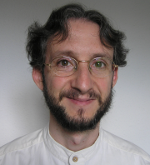 F. Javier Romeo-Biedma es psicólogo clínico, está certificado como Formador de Focusing y como Psicoterapeuta con Orientación de Focusing, en Madrid, España, y es consultor internacional en Protección de Infancia, Afectividad y Comunicación Interpersonal en Spirals tus me nyuam consulting (una empresa de consultoría internacional que forma y asesora en Protección de Infancia). Su trabajo con niños, niñas, adolescentes y jóvenes en riesgo social en España, Marruecos y Mauritania le han conducido a investigar sobre la prevención, detección y sanación de la violencia (y eso incluye una profunda experiencia en Comunicación No Violenta). También practica psicoterapia y enseña Focusing, Comunicación No Violenta y Psicología en Tiag tiag mas kev twb kev txuas. Ha impartido formaciones en español (su lengua materna), Aaskiv, francés y árabe marroquí.
F. Javier Romeo-Biedma es psicólogo clínico, está certificado como Formador de Focusing y como Psicoterapeuta con Orientación de Focusing, en Madrid, España, y es consultor internacional en Protección de Infancia, Afectividad y Comunicación Interpersonal en Spirals tus me nyuam consulting (una empresa de consultoría internacional que forma y asesora en Protección de Infancia). Su trabajo con niños, niñas, adolescentes y jóvenes en riesgo social en España, Marruecos y Mauritania le han conducido a investigar sobre la prevención, detección y sanación de la violencia (y eso incluye una profunda experiencia en Comunicación No Violenta). También practica psicoterapia y enseña Focusing, Comunicación No Violenta y Psicología en Tiag tiag mas kev twb kev txuas. Ha impartido formaciones en español (su lengua materna), Aaskiv, francés y árabe marroquí.
Nyeem daim ntawv no rau lus Askiv.
[Keeb kwm ntawm lub teb chaws 27 ntuj 2016, kho tshiab 23 Lub Xya hli ntuj ntawm 2016, Neeg ua hauj lwm hnub].
kev ua hauj lwm “Finding a Handle for Violence In Our Lives” at the International Focusing Conference 2016, Cambridge (uk)
23 Lub Xya hli ntuj 2016.
Cim npe: Txheej txheem archived, Qwj CI, Focusing, Kev kawm, Lus Askiv, Hlwb, Kho
 kev ua hauj lwm “Finding a Handle for Violence In Our Lives” thaum nyob tom 27th International Focusing Conference 2016 in Cambridge (uk), organised by the British Focusing Association, open to members of Rau lub koom haum Focusing from all over the world.
kev ua hauj lwm “Finding a Handle for Violence In Our Lives” thaum nyob tom 27th International Focusing Conference 2016 in Cambridge (uk), organised by the British Focusing Association, open to members of Rau lub koom haum Focusing from all over the world.
Dates: New date: Saturday 23rd July 2016, from 11:00 to 13:00.
Chaw: Robinson College
Cambridge
United Kingdom
Description: When we work with children and youth, with at-risk populations, in social settings, with clients in therapy, we can see the effects of violence in their lives. In this workshop we will work experientially to find a handle for violence in our own lives, as the first step to prevent and detect situations of violence. We will explore how to identify violence from a Focusing and embodied perspective to empower ourselves –transforming violence around us.
Target audience: professionals (psychologists, therapists, educators, social workers, li ntawd.) working with children and youth, with at-risk populations, with clients in therapy; people working for social change (associations, foundations, li ntawd.); and general public interested in dealing with violence in new ways.
Facilitator:
 F. Javier Romeo-Biedma is a clinical psychologist, Certified Focusing Trainer and Psychotherapist based in Madrid, Spain, and an international consultant on Child Protection, Affectivity and Communication at Spirals tus me nyuam consulting (an international consultancy firm he co-founded that provides training and assessment in Child Protection). His work with at-risk children and youth in Spain, Morocco and Mauritania has led him to research on violence prevention, detection and healing (including a deep experience in Nonviolent Communication). He also has a private practice and teaches Focusing, Nonviolent Communication and Psychotherapy at Tiag tiag mas kev twb kev txuas. He has taught in Spanish (his mother tongue), Aaskiv, French and Moroccan Arabic.
F. Javier Romeo-Biedma is a clinical psychologist, Certified Focusing Trainer and Psychotherapist based in Madrid, Spain, and an international consultant on Child Protection, Affectivity and Communication at Spirals tus me nyuam consulting (an international consultancy firm he co-founded that provides training and assessment in Child Protection). His work with at-risk children and youth in Spain, Morocco and Mauritania has led him to research on violence prevention, detection and healing (including a deep experience in Nonviolent Communication). He also has a private practice and teaches Focusing, Nonviolent Communication and Psychotherapy at Tiag tiag mas kev twb kev txuas. He has taught in Spanish (his mother tongue), Aaskiv, French and Moroccan Arabic.
Ver esta misma entrada en español.
[Original post of May 27th. 2016, updated on July 23rd. 2016, date of the workshop].
“Kev hwm” (“Hwm rau kuv, Hwm kom Ti”), Bridget Belgrave khoom tawg yooj yim rau kev ua hauj lwm nrog cov me nyuam hluas thiab cov neeg uas tsis yog-tsausmuag sib txuas lus
18 Cuaj hlis 2015.
Cim npe: CNV, Kev sib txuas lus zag, Kev kawm, Kev kawm, Lus Askiv, CNV sav, Yeeb yaj duab
El pasado fin de semana del 12 thiab 13 Cuaj hlis ntawm 2015 he tenido el privilegio y el placer de colaborar de nuevo con Bridget Belgrave. Como ya he comentado en esta entrada, conocí a Bridget Belgrave Thiab Gina Lawrie, Formadoras Certificadas por el Centro para la Comunicación No Violenta (Center for NonViolent Communication, CNVC), hauv 2009 y desde aquel momento comenzamos a trabajar en equipo para traducir las CNV Dance Floors al castellano. Las traducciones completas vieron finalmente la luz en 2014, con unos vídeos ilustrativos que se pueden ver esta entrada que hice para su lanzamiento. Tus Koom haum rau Nonviolent Communication ha organizado una serie de formaciones en Madrid, Bilbao y Barcelona durante septiembre de 2015, y para mí ha sido una satisfacción de trabajar de nuevo en equipo con Bridget Belgrave apoyando con la traducción del inglés al castellano y viceversa.
En la preparación del taller he dedicado tiempo a repasar todos los materiales que tengo de las CNV Dance Floors Thiab Bridget en particular. Y valorando todos los materiales, cada uno con su riqueza, hay uno que sigue siendo mi favorito. De hecho, Bridget me invitó a compartir mi visión en cierto momento del taller, y se me ha ocurrido hacer extensiva mi recomendación también en este blog.
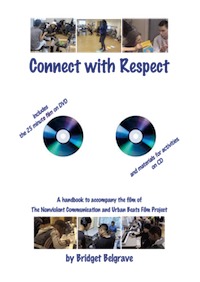 El material en cuestión está solo en inglés y no tiene subtítulos ni traducciones disponibles, Tab sis kuv vam tias tsis discourage koj los nce nws.. “Kev hwm” (“Txuas los ntawm hwm”, Cia txhais ua lus Mev) Yog ib tug multimedia khoom documenting ib qhov project ris los bridget Belgrave nyob rau hauv 2004 Nrog 21 cov tub ntxhais hluas thiab cov hluas uas muaj hnub nyoog li ntawm xya xyoo. Peb tes num yog npaj tseg ua ib qho kev cuam tshuam los qhia cov tub hluas thiab cov ntxhais uas muaj teeb meem ntawm kev nyuaj siab nyob rau hauv Kev sib txuas lus tsis-tsausmuag, Tsis pub dhau lub framework ntawm ib workshop rau lub creation ntawm urban rhythms, kaum as thiv.
El material en cuestión está solo en inglés y no tiene subtítulos ni traducciones disponibles, Tab sis kuv vam tias tsis discourage koj los nce nws.. “Kev hwm” (“Txuas los ntawm hwm”, Cia txhais ua lus Mev) Yog ib tug multimedia khoom documenting ib qhov project ris los bridget Belgrave nyob rau hauv 2004 Nrog 21 cov tub ntxhais hluas thiab cov hluas uas muaj hnub nyoog li ntawm xya xyoo. Peb tes num yog npaj tseg ua ib qho kev cuam tshuam los qhia cov tub hluas thiab cov ntxhais uas muaj teeb meem ntawm kev nyuaj siab nyob rau hauv Kev sib txuas lus tsis-tsausmuag, Tsis pub dhau lub framework ntawm ib workshop rau lub creation ntawm urban rhythms, kaum as thiv.
Vim li cas kuv thiaj xav kom nws?? Ntawm no yog ib txoj kev xaus ntawm kuv cov txheej xwm:
- Tus DVD nrog lub yeeb yam, ntawm 25 feeb. Sau cov moments fundamental moments ntawm peb tes num, Kaw ob leeg los ntawm cov trainers peb trainers thiab los ntawm cov hluas lawv tus kheej, thiab edited hauv tswv yim nrog lawv. De hecho, Hais rau ib zajlus zajlus, el hecho de visionar sesiones anteriores les ayudó a todos a ser más conscientes de su propio aprendizaje y a conseguir comportamientos que se adecuasen mejor a las necesidades de todo el mundo. Es un documento gráfico que permite poner caras (y sonidos) a las distintas situaciones, y permite imaginar cómo aplicarlo en otros contextos.
- El vídeo esta complementado con la segunda parte del libro, “Guide to the Film” (“Guía para ver la película”), en la que se comenta secuencia por secuencia todo lo que ocurre: cada situación, cómo se enseña la Comunicación No Violenta, los momentos de práctica, los conflictos reales que surgen… De este modo se comprenden mejor la intención de cada actividad y las dificultades que surgieron y cómo se afrontaron.
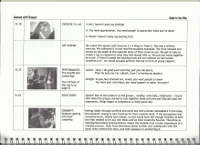
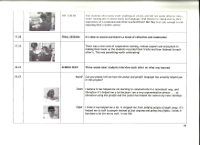
- Y la tercera parte del libro recoge el programa completo, las diez semanas con todos sus ejercicios detallados y todos los materiales maquetados además (Lus Askiv), además de incorporar un CD-ROM con el archivo de cada material en PDF listo para imprimir. Evidentemente el vídeo no recoge todos los ejercicios, así que resulta muy útil ver la progresión actividad a actividad, con la posibilidad de replicarlo.
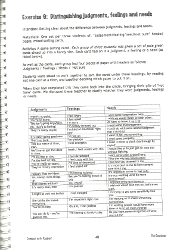
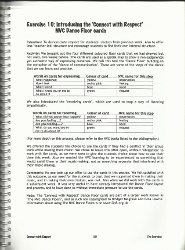
- El hecho de disponer de una traducción de lo que es la Pista de Baile en sí al Lus Mev, con el título de “Hwm rau kuv, Hwm kom Ti”, dentro del paquete completo de Pistas de Baile.
- Thiab cov advertencia de Bridget Belgrave de no intentar un proyecto de este estilo sin tener por un lado una sólida formación y experiencia en Comunicación No Violenta, y por otro lado un equipo educativo con cierta base de CNV y con experiencia en trabajo con adolescentes. Yo he hecho algunos de estos ejercicios con adolescentes y jóvenes en riesgo social en Madrid y salió bien, así que estoy disponible.
En resumen, un material que merece la pena ver, leer, releer y poner en práctica. Y que podéis comprar en su tienda online, Life Resources.
Y si queréis más aclaraciones, podéis llamarme a mi teléfono de contacto y comentamos lo que queráis.
¡Espero que pronto podamos tener más proyectos de este estilo por aquí!
Javier
Xyaum ua tej yam kom haum rau lub tsev kawm ntawv, Ib txoj kev tshiab uas resolving tej teeb meem
5 Tej zaum 2015.
Cim npe: CNV, Kev sib txuas lus zag, Kev kawm, Lus Askiv, Niam thiab txiv, CNV sav, Lwm tus ntawv, Yeeb yaj duab, Cov websites
Feem ntau cov teeb meem yuav raug muab daws nyob rau hauv ib satisfactory thiab mutually beneficial manner., muab tias cov chaw muab kev pab tsim nyog thiab lub sij hawm yog devoted. Uas yog kuv tus kheej thiab kev kawm ntawm kev kawm ntawv, xyaum thiab kis tus kab mob Kev sib txuas lus tsis-tsausmuag. Nws yog ib qho yooj yim (tsis yoojyim) Raws li yog hais tias cov neeg mob tsim nyog tau ntsib rau qhov teeb meem ntawd.. Rau kuv muaj ntau lub caij tseem ceeb, uas yuav tau summarized nyob rau hauv cov nram qab no:
- Ib txoj kev tsim nyog methodology, Uas tso cai rau ob tog koom tes nrog kev ruaj ntseg thiab respected nyob rau hauv lawv txoj cai.
- Cov tub txawg tub ntse uas muaj kev kawm nyob rau hauv lub rooj hais kom sib haum thiab sib sib zog nqus peev xwm mloog thiab sib sib zog nqus peev xwm mloog thiab “kev txhais lus” Hais kom lawv yooj yim mus hnov rau txhua tus neeg.
- Ib lub zej zog uas txhawb restorative processes, Siv sijhawm los siv sijhawm, tej qhov chaw, tib neeg qhov chaw muab kev pab, daim ntawv ua…
- Cov neeg kam daws teeb meem nyob rau hauv ib txoj kev uas kawg ob tog hnov thiab tias ob tog yuav txaus siab rau cov tshuaj.
Yog vim li cas nws yog ib txoj kev kaj siab lug rau kuv muab cov chaw muab kev pab tsim los ntawm ib lub zej zog dav ntawm cov neeg nyob hauv lub zej zog ntawm Son Gotleu hauv Palma tsib Mallorca (Majorca), Vim lawv sau li cas lawv tau ua haujlwm txhua yam ntawm cov hais.
Nyob rau hauv no yees duab koj yuav pom li cas lawv tau muab kev koom tes, nrog lub dynamization ntawm tus dynamization ntawm tus Institut per a la Convivència i el Èxit Escolar (tus Lub koom haum rau Coexistence thiab tsev kawm ntawv kawm tau zoo nyob Spanish) Ntawm tsoom fwv ntawm lub Balearic Islands tuaj, Los ntawm cov neeg ua hauj lwm hauv kev qhia ntawv ntawm cov chaw kawm ntawv thaum ntxov Ntawm Kev Kawm Ntawv Thaum Yau, Primary and Secondary, Cov me nyuam kawm ntawv muaj hnub nyoog li cas, Yim, thiab social Services, Tub ceev xwm, tsev kawm ntawv thiab lwm cov pab pawg neeg tseem ceeb. Hauv mosaic ntawm cov suab lus nws, Peb tau txais ib lub tswv yim ntawm txoj kev tsim no kev ruaj ntseg nuj nyob rau hauv ib cheeb tsam socially lam tau lam ua, thiab peb pom tej yam tshwm sim.
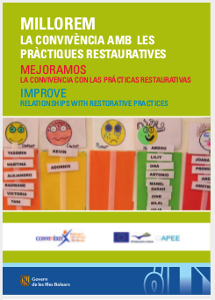 Rau ib tug saib systematic saib, Nws muaj nws daim ntawv uas muaj xws li cov fundamental aspects. Luam tawm nyob rau hauv Catalan, Spanish thiab Lus Askiv nyob rau hauv lub framework ntawm ib qhov project nyob sab Europe peb tes num nrog lawv, qhov Millorem qhia nyob nrog Restorative Practices/guide peb txhim kho coexistence nrog Restorative Xyaum tsim lub theoretical nam ntawm Restorative Practices, Xav tau ntaub ntawv ntxiv thiab muab cov qauv piv txwv thiab nyeem cov tswv yim kom paub ntxiv.
Rau ib tug saib systematic saib, Nws muaj nws daim ntawv uas muaj xws li cov fundamental aspects. Luam tawm nyob rau hauv Catalan, Spanish thiab Lus Askiv nyob rau hauv lub framework ntawm ib qhov project nyob sab Europe peb tes num nrog lawv, qhov Millorem qhia nyob nrog Restorative Practices/guide peb txhim kho coexistence nrog Restorative Xyaum tsim lub theoretical nam ntawm Restorative Practices, Xav tau ntaub ntawv ntxiv thiab muab cov qauv piv txwv thiab nyeem cov tswv yim kom paub ntxiv.
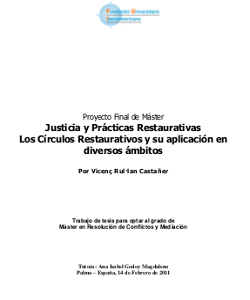 Thiab deepen lub voj voog Restorative, Ib txoj kev xyaum daws teeb meem uas muaj kev dimension originating hauv lub Kev sib txuas lus tsis-tsausmuag, Koj yuav nyeem cov nthuav monograph Kev ncaj ncees thiab Restorative Practices. Los Círculos Restaurativos y su aplicación en diversos ámbitos, redactada por Vicenç Rul·lan, un formador al que tengo el placer de conocer, que aparece en el vídeo y en la Guía, y que es miembro de la Associació de Justícia i Pràctiques Restauratives de Balears (con página en Lus Mev y en catalán, con varios recursos más). Una buena introducción, para seguir profundizando en este modelo en concreto. Y también se pueden ver vídeos (Lus Askiv) en la página web oficial del creador de los Círculos Restaurativos, Dominic Barter, RestorativeCircles.org.
Thiab deepen lub voj voog Restorative, Ib txoj kev xyaum daws teeb meem uas muaj kev dimension originating hauv lub Kev sib txuas lus tsis-tsausmuag, Koj yuav nyeem cov nthuav monograph Kev ncaj ncees thiab Restorative Practices. Los Círculos Restaurativos y su aplicación en diversos ámbitos, redactada por Vicenç Rul·lan, un formador al que tengo el placer de conocer, que aparece en el vídeo y en la Guía, y que es miembro de la Associació de Justícia i Pràctiques Restauratives de Balears (con página en Lus Mev y en catalán, con varios recursos más). Una buena introducción, para seguir profundizando en este modelo en concreto. Y también se pueden ver vídeos (Lus Askiv) en la página web oficial del creador de los Círculos Restaurativos, Dominic Barter, RestorativeCircles.org.
Quienes habéis hecho alguna formación de comunicación interpersonal conmigo habéis visto que suelo mencionar este tema de las Prácticas Restaurativas. Espero que estos recursos ilustren un poco mejor lo que me habéis oído y confío en que despierten vuestra creatividad y vuestra imaginación para seguir descubriendo maneras más eficaces y más profundas de resolver conflictos en el entorno educativo, y en cualquier otro ámbito.
Javier
En memoria de Mary Hendricks-Gendlin, referencia de Focusing
14 Tim 2015.
Cim npe: Focusing, Lus Askiv, Hlwb, Kho, Sav Focusing, Yaam puab paub, Cov websites
yav tag los 28 Lub peb hlis ntuj 2015 fallecía Marion (conocida mejor como “Mary”) N. Hendricks-Gendlin, una referencia imprescindible en cuanto al Focusing. Yo me encuentro entre quienes, sin haberla conocido directamente, recibimos la herencia de su trabajo y de su espíritu.
Mary Hendricks-Gendlin fue, entre otros aspectos de su vida, psicóloga, Psychotherapist nrog Focusing kev taw qhia, miembro fundacional de Rau lub koom haum Focusing (el Instituto de Focusing de Nueva York) y directora del mismo durante muchos años. También ha sido la pareja de Gene Gendlin, quien dio forma al proceso de Focusing y que continúa vivo, y la madre de Elissa, la hija que tuvieron en común.
Para mí la referencia de Mary Hendricks-Gendlin llega principalmente a través de Isabel Gascon, Coordinadora de Focusing española y mi formadora de referencia (después de haberme certificado, sigo aprendiendo de ella en cada contacto que tenemos, personal o profesional). Isabel Gascon, por su larga trayectoria en Focusing y por su representación del Instituto Español de Focusing para temas internacionales (en especial como vicepresidenta), ha tenido mucho contacto con Mary, incluso en los últimos años, cuando Gene y Mary han dejado la dirección de Rau lub koom haum Focusing (el Instituto de Focusing de Nueva York). Precisamente, una semana antes del fallecimiento de Mary, hauv Jornadas Nacionales de Focusing de 2015 nyob rau hauv Miraflores tsib la Sierra, el sábado 21, Isabel Gascón nos estuvo comentando a varios participantes su vivencia de Mary y de Gene, con mucho cariño y ternura, y desde la admiración de todo lo que han hecho ambos, apoyándose entre sí. Recomiendo leer el sentido homenaje de Isabel Gascón en su página web.
La herencia que recibimos quienes no la hemos conocido directamente tiene muchas formas:
- Un Instituto de Focusing sólido, que Mary y Gene han conducido a una transición hacia una nueva organización ajustada a la realidad internacional y multidisciplinar del Focusing.
- Una difusión internacional del Focusing, que para ella ha sido fundamental durante su tiempo como directora. Me parece imprescindible su artículo “Felt Sense Literacy” (disponible también en español como “Alfabetización de la sensación sentida”), una conmovedora visión del Focusing como fuerza de transformación de la sociedad.
- El apoyo a la creación de aspectos tan importantes para el Focusing como los grupos “Changes” (“Cambios”), grupos de intercambio de Focusing entre practicantes.
- Su investigación en diversos ámbitos actuales del Focusing, como la Psicoterapia con Orientación de Focusing y el “Thinking At the Edge -TAE” (“Pensando Desde el Borde – PDB”).
- Su concepto de la “Pausa Revolucionaria”, que consiste en darnos tiempo antes de actuar, antes de responder, en parar y ver cómo vive nuestro cuerpo cada situación. De este modo podemos conseguir una mayor autenticidad de las decisiones. Se puede leer su impresionante artículo “Focusing as a Force for Peace: The Revolutionary Pause” (solo en inglés por el momento), en el que las primeras líneas son conmovedoras por su sencillez y profundidad, y donde el resto del texto desarrolla desde distintos puntos de vista el concepto de “Pausa Revolucionaria”.
Desde aquí va mi agradecimiento a Mary Hendricks-Gendlin y mi homenaje a su vida y a su trabajo, que también han tocado mi vida. Y mi cariño y cuidado a Gene Gendlin y hacia todas las personas que han querido a Mary, y que han perdido no solo a una profesional imprescindible, sino también además a una maestra, acompañante y amiga querida, como revelan los comentarios de la página de homenaje de Rau lub koom haum Focusing.
Con respeto y cuidado,
Javier
Lub website ntawm tus Focusing lub koom haum of New York (Rau lub koom haum Focusing)
7 Lub kaum hli ntuj 2014.
Cim npe: Focusing, Lus Askiv, Sav Focusing, Cov websites
Ib qhov chaw muab kev pab kom paub Focusing yog qhov New York Focusing lub koom haum lub website, Rau lub koom haum Focusing. Lub koom haum yog qhov chaw uas coordinates ntawm tus tseev tsim ntiaj teb theem dissemination ntawm Focusing thiab tus tseev tsim ntiaj teb daim ntawv pov thawj ntawm Focusing professionals. Nrog no tswv yim, lub website muaj abundant chaw muab kev pab nyob rau hauv cov kev sib nrauj tshaj plaws..
Nws muaj ib seem nyob rau hauv Lus Mev, Qhov twg ob peb platory phau ntawv txog Focusing thiab ib co ntaub ntawv tshwm sim, nrog rau kuv tsab xov xwm “Yuav ua li cas yuav muab tau kev sib txuas lus Focusing thiab nonviolent: Muaj kev cuam tshuam li no: cov uas siv tau”.
Nplooj ntawv loj, Nws yog lus Askiv, Nws muaj ntau seem, xws li:
- Xyaum Kom Paub Focusing (Kawm focusing).
- Dab tsi yog ua nyob rau hauv lub zej zos Focusing zej zog (Muaj kev zej zog), xov xwm (Ntawv Xov Xwm) Uas zoo nkaus li ob peb zaug ib xyoos thiab Lub Folio. Ib phau ntawv Journal rau txoj kev kho Focusing thiab Experiential, Tus nom Academic Journal.
- Cov ntaub ntawv thiab thaum lawv tseem focusing nyob rau ntau hom thiab txawv audiences (Focusing thiab…).
- Hauv khw hauv internet (Focusing Store), Koj yuav pom los ntawm phau ntawv loj, Yeeb yaj duab thiab audios, Txawm tias feem ntau cov ntawv nyeem nyob spanish zoo nyob rau hauv lub website ntawm lub website Spanish lub koom haum ntawm Focusing.
Tshwj xeeb tshaj yog nyiam yog tus Eugene Gendlin Online Library (Gendlin Online Library), Koj yuav saib tau tus thawj version qhib (Lus Askiv los yog German) 175,000 articles nws tau luam tawm Tus sau phau ntawv ntawm Focusing, Thiab qhov twg koj kuj nyeem heev txog cov philosophical nam ntawm no cuab yeej, qhov Philosophy ntawm lub Implicit (Lub Philosophy ntawm lub Implicit).
Kuv caw koj tuaj soj ntsuam thiab nrhiav tau cov chaw muab kev pab ntawm nplooj ntawv no, n nth noj lub sij hawm nws deserves.
Kuv vam tias koj nrhiav tau nws li enriching li kuv ua.
Javier
CNV Dance Floors: practicar la Comunicación No Violenta de una forma integral
25 Cuaj hlis 2014.
Cim npe: CNV, Kev sib txuas lus zag, Kev kawm, Lus Askiv, Kuv nthuav tawm, Rau cov hluas, Rau cov tub thiab cov ntxhais, Niam thiab txiv, Hlwb, Kho, CNV sav, Yeeb yaj duab
Las Pistas de Baile CNV ya han aparecido en su versión en castellano, en la que he colaborado, y también están disponibles los vídeos subtitulados en español.
Bridget Belgrave thiab Gina Lawrie, Formadoras Certificadas por el Centro para la Comunicación No Violenta (Center for NonViolent Communication, CNVC), crearon hace años una magnífica herramienta para enseñar y practicar la Comunicación No Violenta (CNV). Como ellas mismas cuentan en su presentación, las CNV Dance Floors (NVC Dance Floors) surgieron a través de una serie de pasos para facilitar la práctica de la Comunicación No Violenta con unos mapas espaciales que permiten utilizar la dimensión corporal para trabajar la dimensión emocional, de la forma que se ve en este vídeo:
En verano de 2009 tuve el placer de formarme con Gina y de conocer a Bridget, y a partir de ahí se retomó el trabajo de traducción y adaptación al castellano, un esfuerzo en el que hemos colaborado muchas personas y que yo he coordinado durante un tiempo. Por eso es un placer difundir una herramienta tan sencilla y a la vez tan profunda, por fin en español, en una versión que hemos cuidado para incluir a la mayor cantidad posible de hispanohablantes.
Mi experiencia es que las CNV Dance Floors las pueden practicar personas con solo unos conocimientos iniciales de Comunicación No Violenta (de hecho yo lo utilizo a veces en los talleres introductorios). Incluso las personas que no conocen el proceso de Comunicación No Violenta en sí (niños, hluas nkauj thiab cov hluas nkauj, clientes en terapia) pueden recorrerlo fácilmente con ayuda de alguien más experimentado.
Las Pistas de Baile CNV combinan lo visual, lo corporal y lo lingüístico, de manera que la experiencia se produce a través de más canales y la vivencia es más profunda. Y hay nueve “danzas” distintas, con nombres tan sugerentes como “La Danza de los 13 Pasos”, “La Danza de Integración y Conexión”, “La Danza de la Ira/Rabia, la Vergüenza y la Depresión”, “La Danza del Sí y del No”, o “Transformar el Dolor de las Necesidades No Cubiertas en la Belleza de las Necesidades”.
Tsis tas li ntawd, hauv 2013 editaron unos vídeos en los que explican tres de estas danzas, en una cuidada edición que incluye subtítulos en español.
Si queréis comprar las Pistas de Baile CNV en distintos formatos (como descarga en PDF, en papel, en versión plastificada…) y los DVD para aprender con ellos en casa o en grupos de práctica, podéis visitar su tienda online, Life Resources.
Y si queréis contar conmigo para probar las Pistas de Baile en sesión individual o en talleres específicos, estaré encantado de acompañaros.
Espero que os gusten.
Javier
